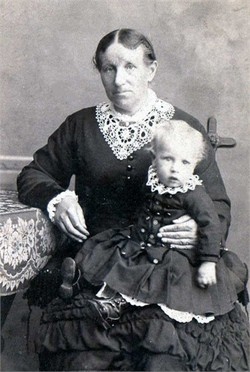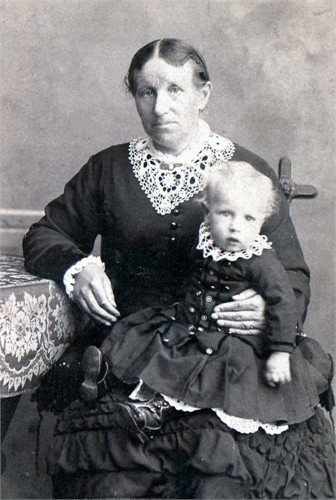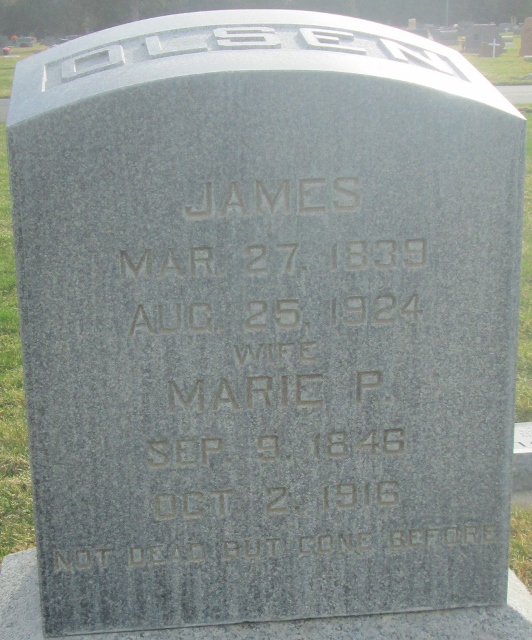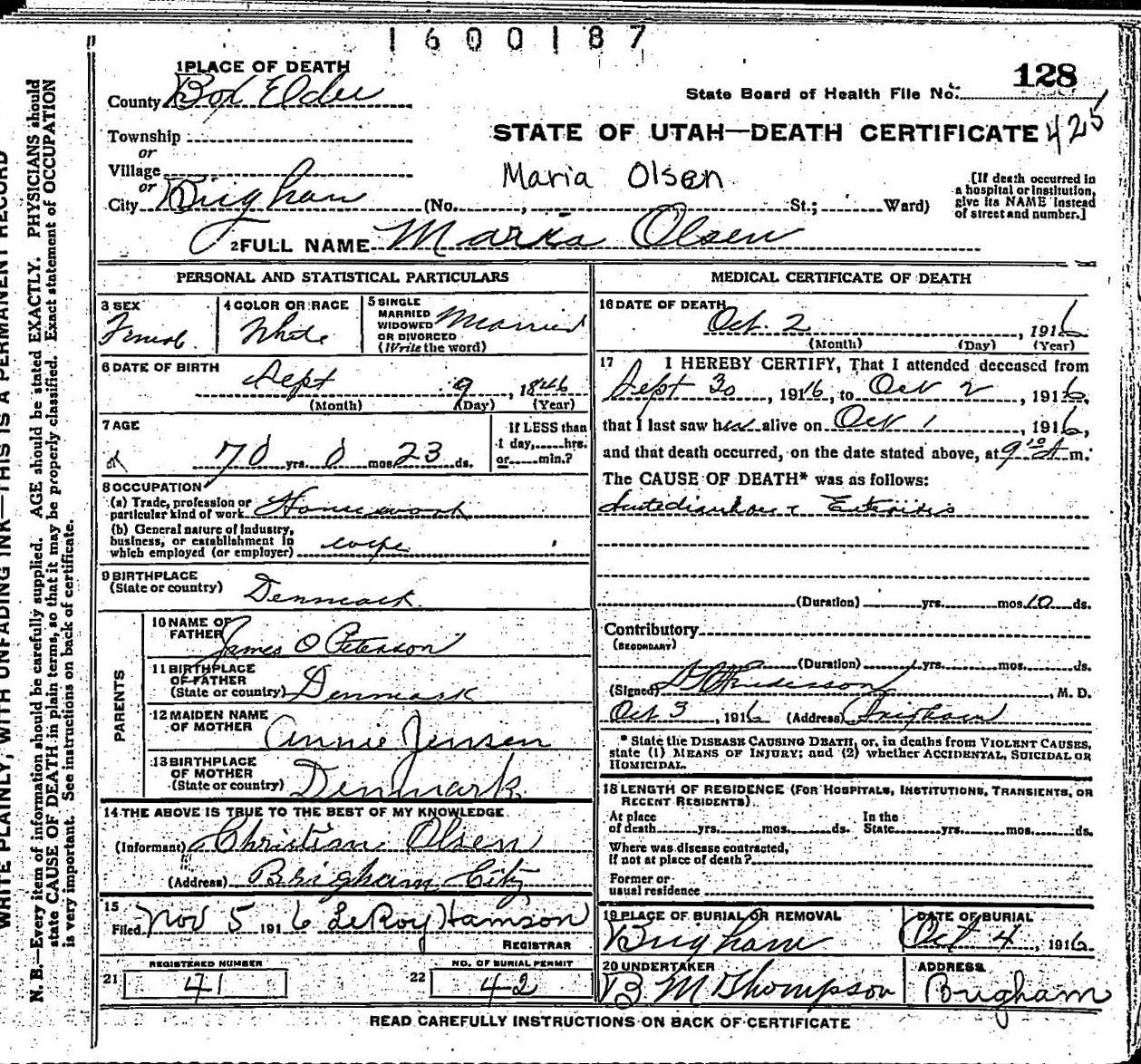Written by her granddaughter, Marie O. Rogers
Marie Peterson Olsen was born near the city of Copenhagen, Denmark, on September 9, 1846, the daughter of James O. Peterson and Anna Jensen.
She began the serious struggle of life under the most rigorous circumstances. Perhaps that condition made it possible for her to endure what she was called upon to endure in after years.
In the winter of 1856, President Brigham Young sent word to the Apostle Franklin D. Richards, who at that time was presiding over the British Mission, to have the emigrants take the northern route through New York and Chicago and land at Iowa City, where they would be provided with handcarts on which to haul their provisions and clothing. Experienced men would be there to aid them in every way possible, but let the Saints understand that they were expected to walk and draw their cart across the plains.
This document was published in the Millennial Star on February 23, 1856, and in the early spring Marie Peterson with her father and mother and five brothers and sisters left Denmark to come to Utah. By June 26, they were at Iowa City among a group of saints numbering 1,620 souls, all anxious to start the long journey across the plains. Before they were able to do this, however, over two hundred and fifty handcarts and dozens of tents had to be made.
The Saints were divided into four different groups or companies. The company under the leadership of James G. Willie was the first to leave. This company consisted of five hundred souls, one hundred and twenty handcarts, five wagons, twenty-four oxen, and forty five beef cattle and cows. The Peterson family was among this company.
On the morning of July 15, they bade farewell to the rest of the good Saints of Camp Iowa and started their thirteen hundred mile journey to the West.
For two hundred miles the country was beautiful, the roads were in good condition, game and fish were plentiful, delicious wild fruits were abundant, the flowers were in bloom and in places the grass was waist high.
While the Saints were passing through this beautiful country the anti-Mormons did everything possible to induce the daughters of Zion to remain with them. The temptation was so great that a number of girls accepted their offer. With the exception of this and the death of one man, the journey from Iowa City to Council Bluffs was nothing more than a pleasure trip.
Several days were spent at Florence, Nebraska, mending carts and getting a fresh supply of food. On August 17, the Willie Company made another start. A few days previous to their start, Grandmother Olsen, along with the rest, received quite a thrill and scare as the company suddenly came upon a band of Indians. As good luck would have it, the Indians were friendly ones, and it turned out to be a thrill for the people from the Old Country to see real live red men.
On September 4, the Indians stole all the beef cattle the Willie Company had. This afterward proved nothing short of a calamity as the food supply was already running short.
On September 9, grandmother Olsen celebrated her tenth birthday. At this tender age she had already walked barefooted many hundred miles across the plains and had many more facing her.
About three hundred miles west of Florence, Nebraska, her life, along with the rest of the company was spared, when they barely escaped being trampled to death by a herd of frightened buffalo.
On the twelfth, when the company was at North Bluff Creek, 613 miles west of Iowa City and with more than half their journey still facing them, their provisions were so short that Captain Willie was compelled to cut rations to fifteen ounces of flour for men, thirteen for women, nine for children and five for babies.
Grandmother's little bare feet were often sore and bleeding and by now the weather was getting cold and miserable. On September 17, the first frost came, but there was no stopping, so, hungry and weary and cold, they plodded on.
On October 12, another cut in rations was made. Every night after the hungry children were put to bed grandmother would wash and dry their clothing, mix their allotted flour with water and bake it in cakes for the next day. This was always done after the children were asleep so that they wouldn't see and cry for something to eat. As she was doing this one night one of the little boys saw her put the cakes under her pillow for safe keeping. Soon she was fast asleep from the drudgery of the day. The hungry little seven year old boy helped himself to the cakes and ate them all so that the rest of the family was entirely without food the next day.
On October 19, the last ounce of flour was doled out to the hungry emigrants. On this same evening it started to snow and by morning eighteen inches had fallen. Here the relief party found them. They were caught in a place where there was neither wood nor shelter and they had not eaten for forty-eight hours. They were literally freezing and starving to death.
Their joy was so great at seeing the relief party that they became hysterical, shouting, crying, and singing. It was some time before they could become quieted down, but as soon as this was accomplished the relief party set about getting wood and making fires to warm the frozen emigrants and cook food for them. Everyone that was able helped with the work. Pot after pot of warm food was cooked until everyone had all he could eat. This was the first time in weeks that they were warm and not hungry, but relief came too late for some, as nine died that night.
From there on the company was in charge of William H. Kimball. It was late the next day before Elder Kimball could get the handcart people started. They were in such a weakened condition that about forty of their number had perished and others were sick and dying. From there to Fort Bridger they suffered untold hardships plodding on through blizzards and bitter cold weather freezing their hands, feet, and faces. They nearly ran out of food again and at Rocky Ridge fifteen Saints died in the night.
They arrived in Fort Bridger, November 2. There they were met by another relief party with trams and wagons and were hauled the rest of the way.
On November 9, at about noon, sixty wagon loads of suffering humanity were in front of the old tithing office building where they were greeted by hundreds of Salt Lake citizens who had anxiously been waiting their arrival.
The scene that followed would be hard to describe. In less than an hour from the time they arrived every soul was being cared for in a manner that brought tears of joy to their bloodshot eyes.
The next spring grandmother moved to Sanpete with the rest of her family where her father worked at different things, receiving a peck of wheat a day for his pay. They lived in Sanpete until the fall of 1858, the year of the move south, when they moved to Brigham City with the people who returned there.
Grandmother did not have the privilege of attending school, but taught herself to read until she became a good reader. She learned to card wool, weave cloth, and knit and sew as did the other girls of her day.
When she was fifteen years of age, on January 28, 1862, she became the bride of James Olsen. When she and grandfather set up housekeeping their sole possessions amounted to a dutch oven, a butcher knife, a buffalo robe, and a pair of blankets plus four willing hands, their faith and trust in God, and a determination to go forward.
They made their home in Brigham for eighteen years while grandfather worked at logging. This left grandmother alone most of the time to take care of the home and the children. She was an excellent housekeeper and cook. She excelled in the art of bread making. In later years when she could afford to make pies she became famous among her friends for her light and flaky pie crust.
In the spring of 1880 they left Brigham and came to Cache Valley.
Written by her granddaughter, Marie O. Rogers
Marie Peterson Olsen was born near the city of Copenhagen, Denmark, on September 9, 1846, the daughter of James O. Peterson and Anna Jensen.
She began the serious struggle of life under the most rigorous circumstances. Perhaps that condition made it possible for her to endure what she was called upon to endure in after years.
In the winter of 1856, President Brigham Young sent word to the Apostle Franklin D. Richards, who at that time was presiding over the British Mission, to have the emigrants take the northern route through New York and Chicago and land at Iowa City, where they would be provided with handcarts on which to haul their provisions and clothing. Experienced men would be there to aid them in every way possible, but let the Saints understand that they were expected to walk and draw their cart across the plains.
This document was published in the Millennial Star on February 23, 1856, and in the early spring Marie Peterson with her father and mother and five brothers and sisters left Denmark to come to Utah. By June 26, they were at Iowa City among a group of saints numbering 1,620 souls, all anxious to start the long journey across the plains. Before they were able to do this, however, over two hundred and fifty handcarts and dozens of tents had to be made.
The Saints were divided into four different groups or companies. The company under the leadership of James G. Willie was the first to leave. This company consisted of five hundred souls, one hundred and twenty handcarts, five wagons, twenty-four oxen, and forty five beef cattle and cows. The Peterson family was among this company.
On the morning of July 15, they bade farewell to the rest of the good Saints of Camp Iowa and started their thirteen hundred mile journey to the West.
For two hundred miles the country was beautiful, the roads were in good condition, game and fish were plentiful, delicious wild fruits were abundant, the flowers were in bloom and in places the grass was waist high.
While the Saints were passing through this beautiful country the anti-Mormons did everything possible to induce the daughters of Zion to remain with them. The temptation was so great that a number of girls accepted their offer. With the exception of this and the death of one man, the journey from Iowa City to Council Bluffs was nothing more than a pleasure trip.
Several days were spent at Florence, Nebraska, mending carts and getting a fresh supply of food. On August 17, the Willie Company made another start. A few days previous to their start, Grandmother Olsen, along with the rest, received quite a thrill and scare as the company suddenly came upon a band of Indians. As good luck would have it, the Indians were friendly ones, and it turned out to be a thrill for the people from the Old Country to see real live red men.
On September 4, the Indians stole all the beef cattle the Willie Company had. This afterward proved nothing short of a calamity as the food supply was already running short.
On September 9, grandmother Olsen celebrated her tenth birthday. At this tender age she had already walked barefooted many hundred miles across the plains and had many more facing her.
About three hundred miles west of Florence, Nebraska, her life, along with the rest of the company was spared, when they barely escaped being trampled to death by a herd of frightened buffalo.
On the twelfth, when the company was at North Bluff Creek, 613 miles west of Iowa City and with more than half their journey still facing them, their provisions were so short that Captain Willie was compelled to cut rations to fifteen ounces of flour for men, thirteen for women, nine for children and five for babies.
Grandmother's little bare feet were often sore and bleeding and by now the weather was getting cold and miserable. On September 17, the first frost came, but there was no stopping, so, hungry and weary and cold, they plodded on.
On October 12, another cut in rations was made. Every night after the hungry children were put to bed grandmother would wash and dry their clothing, mix their allotted flour with water and bake it in cakes for the next day. This was always done after the children were asleep so that they wouldn't see and cry for something to eat. As she was doing this one night one of the little boys saw her put the cakes under her pillow for safe keeping. Soon she was fast asleep from the drudgery of the day. The hungry little seven year old boy helped himself to the cakes and ate them all so that the rest of the family was entirely without food the next day.
On October 19, the last ounce of flour was doled out to the hungry emigrants. On this same evening it started to snow and by morning eighteen inches had fallen. Here the relief party found them. They were caught in a place where there was neither wood nor shelter and they had not eaten for forty-eight hours. They were literally freezing and starving to death.
Their joy was so great at seeing the relief party that they became hysterical, shouting, crying, and singing. It was some time before they could become quieted down, but as soon as this was accomplished the relief party set about getting wood and making fires to warm the frozen emigrants and cook food for them. Everyone that was able helped with the work. Pot after pot of warm food was cooked until everyone had all he could eat. This was the first time in weeks that they were warm and not hungry, but relief came too late for some, as nine died that night.
From there on the company was in charge of William H. Kimball. It was late the next day before Elder Kimball could get the handcart people started. They were in such a weakened condition that about forty of their number had perished and others were sick and dying. From there to Fort Bridger they suffered untold hardships plodding on through blizzards and bitter cold weather freezing their hands, feet, and faces. They nearly ran out of food again and at Rocky Ridge fifteen Saints died in the night.
They arrived in Fort Bridger, November 2. There they were met by another relief party with trams and wagons and were hauled the rest of the way.
On November 9, at about noon, sixty wagon loads of suffering humanity were in front of the old tithing office building where they were greeted by hundreds of Salt Lake citizens who had anxiously been waiting their arrival.
The scene that followed would be hard to describe. In less than an hour from the time they arrived every soul was being cared for in a manner that brought tears of joy to their bloodshot eyes.
The next spring grandmother moved to Sanpete with the rest of her family where her father worked at different things, receiving a peck of wheat a day for his pay. They lived in Sanpete until the fall of 1858, the year of the move south, when they moved to Brigham City with the people who returned there.
Grandmother did not have the privilege of attending school, but taught herself to read until she became a good reader. She learned to card wool, weave cloth, and knit and sew as did the other girls of her day.
When she was fifteen years of age, on January 28, 1862, she became the bride of James Olsen. When she and grandfather set up housekeeping their sole possessions amounted to a dutch oven, a butcher knife, a buffalo robe, and a pair of blankets plus four willing hands, their faith and trust in God, and a determination to go forward.
They made their home in Brigham for eighteen years while grandfather worked at logging. This left grandmother alone most of the time to take care of the home and the children. She was an excellent housekeeper and cook. She excelled in the art of bread making. In later years when she could afford to make pies she became famous among her friends for her light and flaky pie crust.
In the spring of 1880 they left Brigham and came to Cache Valley.
Family Members
-
![]()
James Olsen Jr
1862–1931
-
![]()
Christian Lorenzo Olsen
1864–1925
-
![]()
Annie Maria Olsen Pearson
1865–1923
-
![]()
Joseph Henry Olsen
1867–1942
-
![]()
Hyrum Olsen
1869–1949
-
![]()
Lovenus Olsen
1871–1939
-
![]()
Denora Olsen
1873–1876
-
![]()
Nephi Olsen
1876–1927
-
![]()
Mary Ellen Olsen Hansen
1878–1910
-
![]()
Erastus Olsen
1880–1954
-
![]()
Sarah Olsen Pett
1882–1971
-
![]()
Moses P Olsen
1883–1971
-
Rachel Olsen
1886–1886
-
![]()
Helana Olsen
1888–1950
Sponsored by Ancestry
Advertisement
Advertisement






























